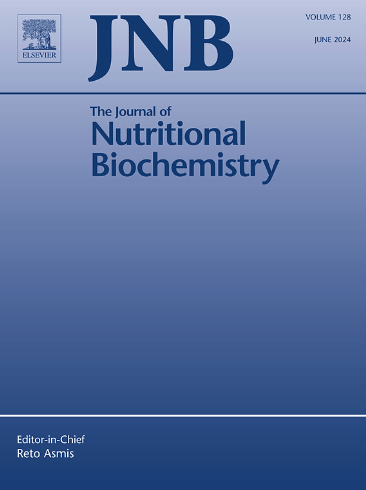Benzyl isothiocyanate ameliorates hepatic insulin resistance in mice with high-fat diet-induced nonalcoholic fatty liver disease
IF 4.8
2区 医学
Q1 BIOCHEMISTRY & MOLECULAR BIOLOGY
引用次数: 0
Abstract
The global prevalence of overweight and obesity has risen sharply over the past few decades as a result of excess calorie intake and sedentary lifestyles. Obesity increases the risk for various metabolic disorders, such as hyperlipidemia, fatty liver disease, and diabetes mellitus. Isothiocyanates, which are abundant in cruciferous vegetables, have been shown to exhibit anticancer, anti-inflammatory, and antioxidant properties. However, the efficacy of benzyl isothiocyanate (BITC) in preventing the adverse effects of obesity, such as hepatic steatosis and insulin resistance, remains uncertain. To address this knowledge gap, we assessed whether BITC protects against hepatic insulin resistance by using primary mouse hepatocytes and AML12 cells treated with palmitic acid (PA) and mice fed a high-fat diet supplemented with cholesterol and cholic acid (HFCCD). We found that the impairments in insulin sensitivity caused by PA, such as decreases in the phosphorylation of insulin receptor substrate (IRS) 1 (Tyr608), Akt, glycogen synthase kinase (GSK) 3β, and FOXO1 and increases in the expression of glucose-6-phosphatase (G6Pase) and phosphoenolpyruvate carboxykinase 1 (PEPCK) mRNA in hepatocytes, were mitigated by pretreatment with BITC. BITC also attenuated PA-induced hepatic lipid accumulation and reactive oxygen species production. In vivo, BITC significantly reduced blood glucose levels and the HOMA-IR and inhibited hepatic lipid accumulation, IRS1 phosphorylation at Ser307, and G6Pase and PEPCK expression compared with that in mice fed the HFCCD alone. These results show that BITC ameliorates the lipotoxicity associated with insulin resistance by activating the IR/IRS/Akt/FOXO1 and GSK3β pathways, which leads to decreased gluconeogenesis and increased glycogen synthesis.

异硫氰酸苄酯改善高脂肪饮食诱导的非酒精性脂肪肝小鼠肝脏胰岛素抵抗
在过去的几十年里,由于摄入过多的卡路里和久坐不动的生活方式,超重和肥胖的全球患病率急剧上升。肥胖增加了各种代谢紊乱的风险,如高脂血症、脂肪肝和糖尿病。十字花科蔬菜中富含异硫氰酸酯,具有抗癌、抗炎和抗氧化的特性。然而,异硫氰酸苄酯(BITC)在预防肥胖的不良反应,如肝脂肪变性和胰岛素抵抗方面的功效仍不确定。为了解决这一知识空白,我们通过使用棕榈酸(PA)处理的原代小鼠肝细胞和AML12细胞,以及喂食高脂肪饮食补充胆固醇和胆酸(HFCCD)的小鼠,评估了BITC是否能预防肝脏胰岛素抵抗。我们发现,PA引起的胰岛素敏感性损伤,如胰岛素受体底物(IRS) 1 (Tyr608)、Akt、糖原合成酶激酶(GSK) 3β和FOXO1磷酸化的降低,以及葡萄糖-6-磷酸酶(G6Pase)和磷酸烯醇丙酮酸羧激酶1 (PEPCK) mRNA表达的增加,可以通过BITC预处理得到缓解。BITC还能减弱pa诱导的肝脏脂质积累和活性氧的产生。在体内,与单独喂食HFCCD的小鼠相比,BITC显著降低了血糖水平和HOMA-IR,抑制了肝脏脂质积累、IRS1 Ser307位点磷酸化以及G6Pase和PEPCK的表达。这些结果表明,BITC通过激活IR/IRS/Akt/FOXO1和GSK3β通路改善与胰岛素抵抗相关的脂肪毒性,导致糖异生减少,糖原合成增加。
本文章由计算机程序翻译,如有差异,请以英文原文为准。
求助全文
约1分钟内获得全文
求助全文
来源期刊

Journal of Nutritional Biochemistry
医学-生化与分子生物学
CiteScore
9.50
自引率
3.60%
发文量
237
审稿时长
68 days
期刊介绍:
Devoted to advancements in nutritional sciences, The Journal of Nutritional Biochemistry presents experimental nutrition research as it relates to: biochemistry, molecular biology, toxicology, or physiology.
Rigorous reviews by an international editorial board of distinguished scientists ensure publication of the most current and key research being conducted in nutrition at the cellular, animal and human level. In addition to its monthly features of critical reviews and research articles, The Journal of Nutritional Biochemistry also periodically publishes emerging issues, experimental methods, and other types of articles.
 求助内容:
求助内容: 应助结果提醒方式:
应助结果提醒方式:


